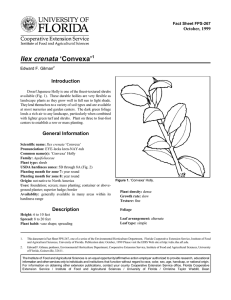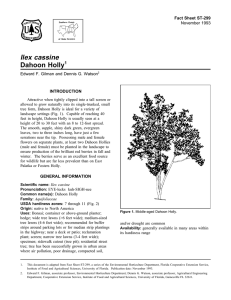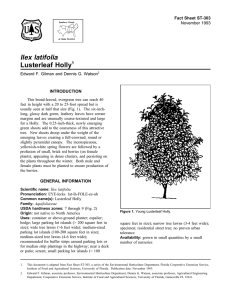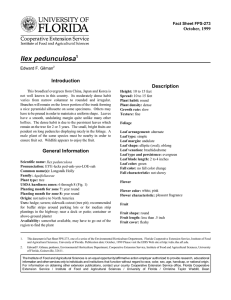Ilex opaca ‘Slim Jim’ ‘Slim Jim’ American Holly Fact Sheet ST-306 1
advertisement

Fact Sheet ST-306 November 1993 Ilex opaca ‘Slim Jim’ ‘Slim Jim’ American Holly1 Edward F. Gilman and Dennis G. Watson2 INTRODUCTION A popular landscape plant since the beginning of American history, this broad-leafed evergreen has served a variety of uses through the years (Fig. 1). The American Indians used preserved Holly berries as decorative buttons and were much sought after by other tribes who bartered for them. The wood has been used for making canes, scroll work and furniture, and has even been substituted for ebony in inlay work when stained black. GENERAL INFORMATION Scientific name: Ilex opaca ‘Slim Jim’ Pronunciation: EYE-lecks oh-PAY-kuh Common name(s): ‘Slim Jim’ American Holly Family: Aquifoliaceae USDA hardiness zones: 6 through 9 (Fig. 2) Origin: native to North America Uses: Bonsai; hedge; recommended for buffer strips around parking lots or for median strip plantings in the highway; reclamation plant; screen; specimen; sidewalk cutout (tree pit); residential street tree; tree has been successfully grown in urban areas where air pollution, poor drainage, compacted soil, and/or drought are common Availability: grown in small quantities by a small number of nurseries Figure 1. Middle-aged ‘Slim Jim’ American Holly. DESCRIPTION Height: 30 to 50 feet Spread: 10 to 15 feet 1. This document is adapted from Fact Sheet ST-306, a series of the Environmental Horticulture Department, Florida Cooperative Extension Service, Institute of Food and Agricultural Sciences, University of Florida. Publication date: November 1993. 2. Edward F. Gilman, associate professor, Environmental Horticulture Department; Dennis G. Watson, associate professor, Agricultural Engineering Department, Cooperative Extension Service, Institute of Food and Agricultural Sciences, University of Florida, Gainesville FL 32611. Ilex opaca ‘Slim Jim’ -- ‘Slim Jim’ American Holly Page 2 Figure 2. Shaded area represents potential planting range. Crown uniformity: symmetrical canopy with a regular (or smooth) outline, and individuals have more or less identical crown forms Crown shape: columnar; pyramidal Crown density: dense Growth rate: slow Texture: medium Foliage Leaf Leaf Leaf Leaf Leaf Leaf arrangement: alternate (Fig. 3) type: simple margin: entire; pectinate; spiny shape: elliptic (oval); lanceolate venation: banchidodrome; pinnate type and persistence: broadleaf evergreen; evergreen Leaf blade length: 2 to 4 inches; less than 2 inches Leaf color: green Fall color: no fall color change Fall characteristic: not showy Flower Flower color: green; white Flower characteristics: pleasant fragrance; inconspicuous and not showy Fruit Fruit Fruit Fruit Fruit Fruit shape: round length: < .5 inch covering: fleshy color: red characteristics: attracts birds; no significant litter problem; persistent on the tree; showy Trunk and Branches Trunk/bark/branches: bark is thin and easily damaged from mechanical impact; droop as the tree grows, and will require pruning for vehicular or pedestrian clearance beneath the canopy; not particularly showy; should be grown with a single leader; no thorns Pruning requirement: needs little pruning to develop a strong structure Breakage: resistant Ilex opaca ‘Slim Jim’ -- ‘Slim Jim’ American Holly Page 3 flowers appear on separate trees and trees of both sexes must be located in the same neighborhood to ensure production of berries on the female plants. American Holly is ideal for use as a street tree (with lower branches removed), framing tree, specimen, barrier planting or screen. Roots are shallow and finely branched, and rarely invasive due to their great number and relatively small diameter. This native tree is ideal for naturalizing on moist, slightly acid soils, and the fruit is very attractive to wildlife, serving as an excellent food source. A 35-foot-tall tree can be 20 feet wide in 40 years. Figure 3. Foliage of ‘Slim Jim’ American Holly. Current year twig color: brown; green Current year twig thickness: medium Wood specific gravity: 0.61 Growing well in full sun to partial shade, American Holly should be located on fertile, welldrained but moist, slightly acid soils below 6.5 pH. Berry production is highest in full sun on female trees. American Holly foliage thins during drought but insect and disease infestations are usually minimal. See the species for other cultivars. Propagation is by cuttings or grafting. Culture Pests Light requirement: tree grows in part shade/part sun; Holly leaf miner larvae mines out the leaf middle leaving yellow or brown trails. tree grows in the shade; tree grows in full sun Soil tolerances: clay; loam; sand; slightly alkaline; acidic; occasionally wet; well-drained Drought tolerance: high Aerosol salt tolerance: high Soil salt tolerance: moderate Scales of various types may infest Holly. Spider mites cause discoloration and speckling of Holly foliage. Other Diseases Roots: surface roots are usually not a problem Winter interest: tree has winter interest due to Tar spot may occasionally cause small yellow spots on the leaves in early summer. Eventually the spots turn reddish brown with narrow yellow borders. Leaves may not drop prematurely but the infected areas drop out leaving holes in the leaves. Gather up and destroy badly infected leaves. unusual form, nice persistent fruits, showy winter trunk, or winter flowers Outstanding tree: not particularly outstanding Invasive potential: little, if any, potential at this time Verticillium wilt susceptibility: not known to be susceptible Pest resistance: long-term health usually not affected by pests USE AND MANAGEMENT This cultivar of American Holly is a beautifully shaped tree, with a symmetrical, dense, narrow pyramidal form. The spiny, dull green leaves are accented with clusters of red berries which persist throughout the fall and winter. Male and female Many different fungi cause leaf spots on Holly. Reduce the injury caused by leaf spots by keeping trees healthy. Dispose of diseased leaves. Cankers caused by several different fungi lead to sunken areas on stems and plant dieback. Keep trees healthy and prune out infected branches. Spine spot is small gray or yellow spots with purple margins and is caused by spines of one leaf puncturing an adjacent leaf. Ilex opaca ‘Slim Jim’ -- ‘Slim Jim’ American Holly Chlorosis symptoms are light green or yellowish leaves with darker green veins. This problem is often due to a high pH leading to iron deficiency. Use acidifying fertilizers and sulfur to bring down the pH. Sprays of iron chelate will green up plants. In northern climates, Hollies sometimes scorch during the late winter due to rapid and wide temperature fluctuations. Shade plants during the winter to prevent the problem. Purple blotches on the leaves are caused by some environmental factor such as nutrient deficiencies, drought, and winter injury. Black root rot can be damaging. Page 4






